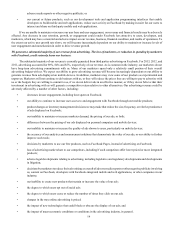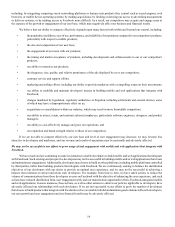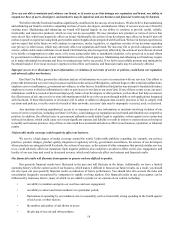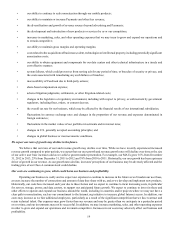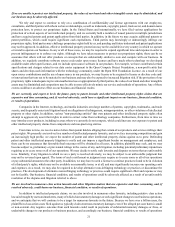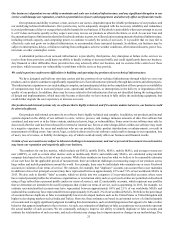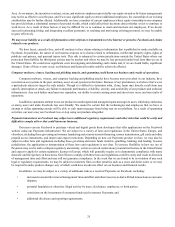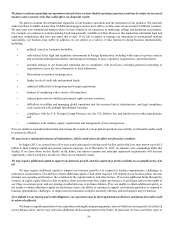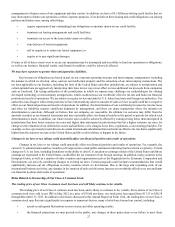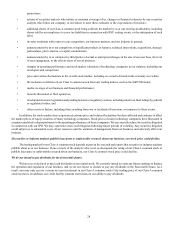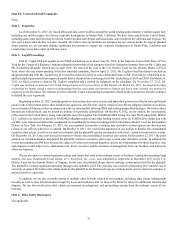Facebook 2013 Annual Report Download - page 26
Download and view the complete annual report
Please find page 26 of the 2013 Facebook annual report below. You can navigate through the pages in the report by either clicking on the pages listed below, or by using the keyword search tool below to find specific information within the annual report.24
to inherent variability in such estimates at particular dates of measurement, we disclose these estimates as a range over a recent period.
Our data limitations may affect our understanding of certain details of our business. For example, while user-provided data
indicates a decline in usage among younger users, this age data is unreliable because a disproportionate number of our younger users
register with an inaccurate age. In the third quarter of 2013, we worked with third parties to develop models to analyze user data by
age in the United States. These models suggested that usage by U.S. teens overall was stable, but that DAUs among younger U.S.
teens had declined. The data and models we are using are not precise and our understanding of usage by age group may not be complete.
Some of our historical metrics through the second quarter of 2012 have also been affected by applications on certain mobile
devices that automatically contact our servers for regular updates with no user action involved, and this activity can cause our system
to count the user associated with such a device as an active user on the day such contact occurs. For example, we estimate that less
than 5% of our estimated worldwide DAUs as of December 31, 2011 and 2010 resulted from this type of automatic mobile activity,
and that this type of activity had a substantially smaller effect on our estimate of worldwide MAUs and mobile MAUs. The impact
of this automatic activity on our metrics varied by geography because mobile usage varies in different regions of the world. In addition,
our data regarding the geographic location of our users is estimated based on a number of factors, such as the user's IP address and
self-disclosed location. These factors may not always accurately reflect the user's actual location. For example, a mobile-only user
may appear to be accessing Facebook from the location of the proxy server that the user connects to rather than from the user's actual
location. The methodologies used to measure user metrics may also be susceptible to algorithm or other technical errors. For example,
in early June 2012, we discovered an error in the algorithm we use to estimate the geographic location of our users that affected our
attribution of certain user locations for the period ended March 31, 2012. While this issue did not affect our overall worldwide DAU
and MAU numbers, it did affect our attribution of users across different geographic regions. We estimate that the number of MAUs
as of March 31, 2012 for the United States & Canada region was overstated as a result of the error by approximately 3% and this
overstatement was offset by understatements in other regions. The number of such users for the period ended March 31, 2012 disclosed
in "Management's Discussion and Analysis of Financial Condition and Results of Operations -- Trends in Our User Metrics" reflect
the reclassification to more correctly attribute users by geographic region. Our estimates for revenue by user location and revenue by
user device are also affected by these factors. We regularly review and may adjust our processes for calculating these metrics to
improve their accuracy. In addition, our DAU and MAU estimates will differ from estimates published by third parties due to differences
in methodology. For example, some third parties are not able to accurately measure mobile users or do not count mobile users for
certain user groups or at all in their analyses. If marketers, developers, or investors do not perceive our user metrics to be accurate
representations of our user base, or if we discover material inaccuracies in our user metrics, our reputation may be harmed and marketers
and developers may be less willing to allocate their budgets or resources to Facebook, which could negatively affect our business and
financial results.
We cannot assure you that we will effectively manage our growth.
Our employee headcount and the scope and complexity of our business have increased significantly, with the number of
employees increasing to 6,337 as of December 31, 2013 from 4,619 as of December 31, 2012, and we expect headcount growth to
continue for the foreseeable future. The growth and expansion of our business and products create significant challenges for our
management, operational, and financial resources, including managing multiple relations with users, marketers, developers, and other
third parties. In the event of continued growth of our operations or in the number of our third-party relationships, our information
technology systems or our internal controls and procedures may not be adequate to support our operations. In addition, some members
of our management do not have significant experience managing a large global business operation, so our management may not be
able to manage such growth effectively. To effectively manage our growth, we must continue to improve our operational, financial,
and management processes and systems and to effectively expand, train, and manage our employee base. As our organization continues
to grow, and we are required to implement more complex organizational management structures, we may find it increasingly difficult
to maintain the benefits of our corporate culture, including our ability to quickly develop and launch new and innovative products.
This could negatively affect our business performance.
The loss of one or more of our key personnel, or our failure to attract and retain other highly qualified personnel in the future,
could harm our business.
We currently depend on the continued services and performance of our key personnel, including Mark Zuckerberg and Sheryl
K. Sandberg. Although we have entered into employment agreements with Mr. Zuckerberg and Ms. Sandberg, the agreements have
no specific duration and constitute at-will employment. In addition, many of our key technologies and systems are custom-made for
our business by our personnel. The loss of key personnel, including members of management as well as key engineering, product
development, marketing, and sales personnel, could disrupt our operations and have an adverse effect on our business.
As we continue to grow, we cannot guarantee we will continue to attract the personnel we need to maintain our competitive
position. In particular, we intend to continue to hire a significant number of technical personnel in 2014 and the foreseeable future,
and we expect to face significant competition from other companies in hiring such personnel, particularly in the San Francisco Bay


